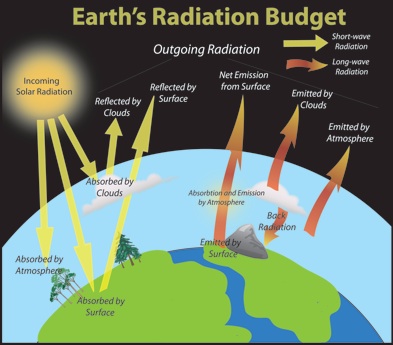









Climate includes the temperature, precipitation, atmospheric circulation and atmospheric chemistry of a region as measured over a period of several seasons to decades.
Temperature differences across the Earth are primarily a result of regional differences in the amount of absorbed solar radiation. Seasonal variations in temperature are the result of the tilt of the Earth’s axis with respect to the Sun.
Precipitation refers to the quantity of water falling to Earth at a specific place within a specified period of time. Like temperature, precipitation varies both spatially and seasonally. The amount of precipitation a region receives can have a dramatic impact on its environmental conditions. For example, regions that receive an abundance of rainfall tend to have profuse and diverse flora and fauna.
Atmospheric circulation refers to the three dimensional patterns of air flow in the atmosphere. These patterns are a major transporter of heat and moisture over the Earth.
Atmospheric chemistry refers to the amount and composition of gaseous, soluble, and non-soluble constituents in the atmosphere. These modulate climate through the scattering or absorption of incoming solar radiation and outgoing terrestrial (longwave heat) radiation.
Plate Tectonics: The movement of the Earth’s crust (plate tectonics) influences climate over periods of millions of years through changes in the geographic arrangement of oceans and continents.
Orbital Cycles: Changes in the tilt, wobble, and eccentricity of the Earth in its orbit around the Sun influence climate on scales of tens to hundreds of thousands of years.
Ocean Circulation: Heat is transferred throughout the global ocean over periods of decades to several thousand years through changes in ocean water circulation (density-driven by temperature and salinity).
Solar Variability: Variations in the energy output of the Sun itself influence climate on time scales of decades to thousands of years.
Ice Dynamics: Ice extent, both as sea ice and terrestrial glacier ice, affects climate by changing Earth’s albedo (reflectivity) and by changing the heat trapping capacity of the ocean. Glacier extent also directly affects sea level and typically impacts climate on scales of thousands of years. Sea ice extent fluctuates annually.
Natural Aerosols: Natural source aerosols (fine airborne particles consisting in part of solid materials) including sea spray, wind blown continental dust, and volcanic materials, impact global climate through differential scattering, absorption, and emission of incoming solar radiation andoutgoing terrestrial radiation. Aerosols have residence times in the atmosphere ranging from hours to several years.



Greenhouse Gases: Greenhouse gases (GHGs) are gases in the atmosphere that absorb and emit thermal radiation (heat). The primary GHGs in the Earth's atmosphere are water vapor (H2O), carbon dioxide (CO2), methane (CH4), nitrous oxide (N2O), and ozone (O3). Greenhouse gases influence climate on scales of decades to hundreds of years.
The Earth’s radiation budget is incoming radiation to Earth must equal outgoing radiation. Absorbed solar radiation (short-wave) increases the Earth's temperature, while emitted long-wave radiation (heat) lowers the temperature. If absorbed solar radiation and emitted heat are in balance, the Earth's temperature will remain constant. Imbalances in the Earth’s radiation budgets leads to temperature changes.

Natural Factors of Climate Change



